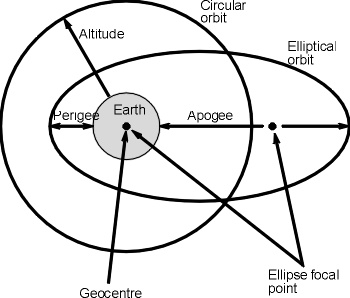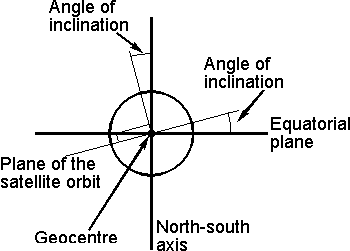Satellite Orbit Types & Definitions
notes and details about satellite orbits: the basics; different types of satellite orbit; & satellite orbit definitions.
Satellite Orbits Includes:
Satellite orbit types & definitions
Low earth orbit, LEO
Geostationary orbit, GEO
Highly elliptical orbit HEO
Techniques for launching satellites into orbit
There are many different satellite orbits that can be used. The ones that receive the most attention are the geostationary orbit used as they are stationary above a particular point on the Earth.
The orbit that is chosen for a satellite depends upon its application. Those used for direct broadcast television, i.e. satellite television for example use a Geostationary orbit. Many communications satellites similarly use a geostationary orbit.
Other satellite systems such as those used for satellite phones may use Low Earth orbiting systems. Similarly satellite systems used for satellite navigation systems like Navstar or Global Positioning (GPS) system occupy a relatively low Earth orbit. There are also many other types of satellite from weather satellites to research satellites and many others. Each will have its own type of orbit depending upon its application.
Also the new Cubesats or cube satellites use relatively low orbits as well in view of te power levels they can transmit and the allowable path losses.
The actual satellite orbit that is chosen will depend on factors including its function, and the area it is to serve. In some instances the satellite orbit may be as low as 100 miles (160 km) for a Low Earth Orbit LEO, whereas others may be over 22 000 miles (36000 km) high as in the case of a GEostationary Orbit GEO. The satellite may even have an elliptical rather than a circular orbit.
Gravity and satellite orbits
As satellites orbit the Earth they are pulled back in by the force of the gravitational field. If they did not have any motion of their own they would fall back to Earth, burning up in the upper reaches of the atmosphere. Instead the motion of the satellite rotating around the Earth has a force associated with it pushing it away from the Earth. For any given orbit there is a speed for which gravity and the centrifugal force balance each other and the satellite remains in a stable orbit, neither gaining height nor loosing it.
Obviously the lower the satellites orbit the Earth, the stronger the gravitational pull, and this means that the satellite must travel faster to counteract this pull. Further away the gravitational field is less and the satellite velocities are correspondingly less. For a very low orbit of around 100 miles a velocity of about 17500 miles per hour is needed and this means that the satellite will orbit the Earth in about 90 minutes. At an altitude of 22 000 miles a velocity of just less than 7000 miles per hour is needed giving an orbit time of about 24 hours.
Circular and elliptical orbit definitions
A satellites orbit the Earth in one of two basic types of orbit.
- Circular satellite orbit: For a circular orbit, the distance from the Earth remains the same at all times.
- Elliptical satellite orbit: The elliptical orbit changes the distance to the Earth

There are a number of definitions associated with various different types of satellite orbits:
- Geocentre : When satellites orbit the Earth, either in a circular or elliptical orbit, the satellite orbit forms a plane that passes through the centre of gravity or geocentre of the Earth.
- Direction of rotation around the Earth: There are two ways in which a satellite orbit may be categorised:
- Posigrade: The rotation around the earth is said to be posigrade when it rotates in the same direction as the rotation of the Earth.
- Retrograde: The rotation around the earth is said to be retrograde when it rotates in the opposite direction to the rotation of the Earth
- Ground track: The ground track of a satellite is point on the Earth's surface where the satellite is directly overhead as it moves around the globe. This forms a circle which has the geocentre at its centre. It is worth noting that geostationary satellites are a special case as they appear directly over the same point of the Earth all the time. This means that their ground track consists of a single point on the Earth's equator. Also for satellites with equatorial orbits the ground track is along the equator.
For these orbits it is usually found that the ground-track shifts towards the west for each orbit because the Earth is rotating towards the east underneath the satellite. - Orbital nodes: These are the points where the ground track passes from one hemisphere to another. There are two for any non-equatorial orbit:
- Ascending node: This is the node where the ground-track passes from the southern hemisphere to the northern hemisphere.
- Descending node: This is the node where the ground-track passes from the northern to the southern hemisphere.
- Satellite height: For many orbit calculations it is necessary to consider the height of the satellite above the geocentre. This is the height above the Earth plus the radius of the Earth. This is generally taken to be 3960 miles or 6370 km.
- Orbit velocity: For a circular orbit it is always the same. However in the case of an elliptical one this is not the case as the speed changes dependent upon the position in the orbit. It reaches a maximum when it is closest to the Earth and it has to combat the greatest gravitational pull, and it is at its lowest speed when it is furthest away.
- Angle of elevation: The angle of elevation is the angle at which the satellite appears above the horizontal. If the angle is too small then signals may be obstructed by nearby objects if the antenna is not very high. For those antennas that have an unobstructed view there are still problems with small angles of elevation. The reason is that signals have to travel through more of the Earth's atmosphere and are subjected to higher levels of attenuation as a result. An angle of five degrees is generally accepted as the minimum angle for satisfactory operation.
- Angle of inclination: Not all satellite orbits follow the equator - in fact most Low Earth Orbits do not. It is therefore necessary to define the angle of inclination of the satellite orbit. The diagram below defines this

Angle of inclination of a satellite orbit
Other satellite orbit considerations
In order that a satellite can be used for communications purposes the ground station must be able to follow it in order to receive its signal, and transmit back to it. Communications will naturally only be possible when it is visible, and dependent upon the orbit it may only be visible for a short period of time. To ensure that communication is possible for the maximum amount of time there are a number of options that can be employed:
- The first is to use an elliptical orbit where the apogee is above the planned Earth station so that the satellite remains visible for the maximum amount of time.
- Another option is to launch a number of satellites with the same orbit so that when one disappears from view, and communications are lost, another one appears. Generally three satellites are required to maintain almost uninterrupted communication. However the handover from one satellite to the next introduces additional complexity into the system, as well as having a requirement for at least three satellites.
Circular satellite orbit definitions
Circular orbits are classified in a number of ways. Terms such as Low Earth orbit, Geostationary orbit and the like detail distinctive elements of the orbit. A summary of circular orbit definitions is given in the table below:
| Satellite orbit definitions |
||||
|---|---|---|---|---|
| Orbit name | Orbit initials | Orbit altitude (km above Earth's surface) | Details / comments | |
| Low Earth Orbit | LEO | 200 - 1200 | ||
| Medium Earth Orbit | MEO | 1200 - 35790 | ||
| Geosynchronous Orbit | GSO | 35790 | Orbits once a day, but not necessarily in the same direction as the rotation of the Earth - not necessarily stationary | |
| Geostationary Orbit | GEO | 35790 | Orbits once a day and moves in the same direction as the Earth and therefore appears stationary above the same point on the Earth's surface. Can only be above the Equator. | |
| High Earth Orbit | HEO | Above 35790 | ||
In some applications high Earth orbits may be required. For these applications the satellite will take longer than 24 hours to orbit the Earth, and path lengths may become very long resulting in additional delays for the round trip from the Earth to the satellite and back as well as increasing the levels of path loss.
The choice of the satellite orbit will depend on its applications. While geostationary orbits are popular for applications such as direct broadcasting or satellite television and for communications satellites, others such as GPS and even those satellites used for mobile phones are much lower. Even the new cubesats use relatively low orbits as a result of their size, transmitter power and the path losses incurred.
In this way the function of the satellite combined with the requirements and allowable path losses govern the orbit into which it must be placed.
 Written by Ian Poole .
Written by Ian Poole .
Experienced electronics engineer and author.
More Essential Satellite Topics:
Interesting facts about satellites
Satellite orbits
Solar outage
Return to Satellite topics menu . . .




